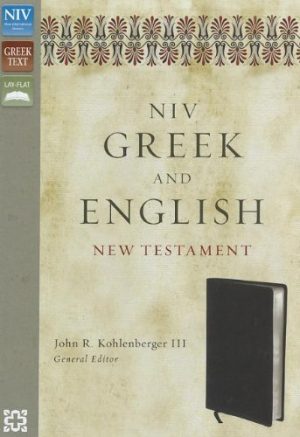Nearly 30 years past my seminary education, I found that my facility with the Greek New Testament was much diminished. I purchased the NIV Greek and English New Testament to remedy that situation. It presents the Greek text underlying the New International Version (NIV) translation on facing pages. (See picture.) I find that this presentation makes it easier for me to determine what Greek words I need to focus on as I write articles or prepare sermons (for those occasions when I preach).

When the NIV translation was updated in 2011, the standard scholarly texts of the Greek New Testament at the time were the United Bible Society’s 4th edition and Nestle-Aland’s 27th edition. UBS and NA are now at 5th and 28th editions, respectively. Like UBS4 and NA27, the Greek text underlying the NIV (NIVGT) is eclectic. It is also largely the same as UBS4 and NA27, though there are 720 footnotes to document its differences from them.
The most notable difference between NIVGT and UB4/NA27 is formatting: “the NIVGT is formatted exactly like the NIV and uses NIV subheads and lists of parallel passages. This presentation makes it much easier to compare the Greek and English.”
One benefit of laying the Greek text alongside the NIV translation is that readers get to see where the NIV’s translation philosophy moves beyond word-for-word translation (formal equivalence) to something more like thought-for-thought translation (functional equivalence).
Take John 1:16, for example. The English Standard Version offers a straightforward formally equivalent translation: “For from his fulness we have all received, grace upon grace.” The NIV, on the other hand, renders it more functionally: “Out of his fullness we have all received grace in place of grace already given.” The Greek phrase underlying the difference between these two translations in the second half of the sentence is kai charin anti charitos. As a reader/preacher, it is helpful to be able to identify where the NIV has gone thought-for-thought to check the reliability of its functional translation in the commentaries, where grammatical considerations such as the kai/anti construction are discussed.
NIV Greek and English New Testament is a well-made product, easy to read, and easy to hold. If you are interested in keeping your Greek skills sharp and use the NIV as your primary translation, this is a good investment. It has been for me at least.
Book Reviewed
NIV Greek and English New Testament, ed. John R. Kohlenberger III (Grand Rapids, MI: Zondervan, 2012).
P.S. If you liked my review, please click “Helpful” on my Amazon review page.

